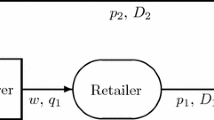Abstract
We analyze decentralized supply chains that follow general continuous review (Q, R) inventory policies subject to vendor-managed inventory agreements where the supplier chooses the order quantity Q, and the retailer chooses the reorder point R. Within the VMI scenario, we explore the effect of divisions of channel power on supply chain and individual agent performance by examining different game theoretic models. Optimal policies and analytical results, including existence and uniqueness proofs for equilibrium solutions under VMI, are derived. Numerical results are provided to compare the effectiveness of VMI and to analyze different channel power relationships under a variety of environmental conditions. We find that VMI can result in considerable supply chain savings over traditional relationships and that the relative division of channel power can significantly effect the performance of VMI. Interestingly, we find that the greatest system benefits from VMI arise in asymmetric channel power relationships, but that individual agents lack the incentive to assume a leadership role.
Similar content being viewed by others
References
Amir R and Stepanova A (2006). Second-mover advantage and price leadership in Bertrand duopoly. Games Econ Behav 55: 1–20
Aviv Y, Federgruen A (1998) The operational benefits of information sharing and vendor managed inventory (VMI) programs. Working paper, Olin School of Business, Washington University, St. Louis, MO
Benton W, Maloni M (2004) The influence of power driven buyer/seller relationships on supply chain satisfaction. J Oper Manage 23:1–22
Bernstein F and Federgruen A (2003). Pricing and replenishment strategies in a distribution system with competing retailers. Oper Res 51(3): 409–426
Bernstein F and Federgruen A (2004). Dynamic inventory and pricing models for competing retailers. Naval Res Logis 51(2): 258–274
Bernstein F and Federgruen A (2005). Decentralized supply chains with competing retailers under demand uncertainty. Manage Sci 51(1): 18–29
Bichescu B and Fry M (2007). A numerical analysis of supply chain performance under split decision rights. Omega. doi:10.1016/j.omega.2007.04.001
Bolen WH (1988). Contemporary retailing, 3rd edn. Prentice Hall, Englewood Cliffs
Boyer M and Moreaux M (1987). On stackelberg equilibria with differentiated products: the critical role of the strategy space. J Ind Econ 36(2): 217–230
Buzzel R, Ortmeyer G (1995) Channel partnerships streamline distribution. Sloan Manage Rev 36:85
Cachon GP (2001). Stock wars: inventory competition in a two-echelon supply chain with multiple retailers. Oper Res 49(5): 658–674
Cachon GP (2003). Supply chain coordination with contracts. In: Graves, S and de Kok, A (eds) Handbooks in operations research and management science, vol 11: Supply chain management: design, coordination and operation, pp 229–339. Elsevier, Amsterdam
Cachon GP and Fisher M (1997). Campbell Soup‘s continuous replenishment program: evaluation and enhanced inventory decision rules. Prod Oper Manage 6(3): 266–276
Cachon GP and Netessine S (2004). Game theory in supply chain analysis. In: Simichi-Levi, D, Wu, SD and Shen, Z-J (eds) Supply chain analysis in the eBusiness Era. Kluwer, Boston
Cachon GP and Zipkin P (1999). Competitive and cooperative inventory policies in a two stage supply chain. Manage Sci 45(7): 936–953
Casella G and Berger RL (1990). Statistical Inference, 1st edn. Brooks/Cole, Belmont
Choi C (1991). Price competition in a channel structure with a common retailer. Market Sci 10(4): 271–296
Clark TH and Hammond J (1997). Reengineering channel reordering processes to improve total supply chain performance. Prod Oper Manage 6(3): 248–265
Clark TH, McKenney JL (1994) Campbell Soup Company: a leader in continuous replenishment innovations. Harvard Business School Case # 195124. Harvard Business School, Harvard University, Cambridge
Corbett CJ (2001). Stochastic inventory systems in a supply chain with asymmetric information: cycle stocks, safety stocks and consignment stock. Oper Res 49(4): 487–500
Corbett CJ, Zhou D and Tang CS (2004). Designing supply contracts: contract type and information asymmetry. Manage Sci 50(4): 550–559
Desiraju R and Moorthy S (1997). Managing a distribution channel under asymmetric information with performance requirements. Manage Sci 43(12): 1628–1644
Emerson RM (1962) Power-dependence relations. Ame Soc Rev 27:31–41
Federgruen A (1993). Centralized planning models for multi-echelon inventory systems under uncertainty. In: Graves, SC, RinnooyKan, AHG and Zipkin, PH (eds) Handbooks in operations research and management science, vol 4 (Logistics of production and inventory), pp 133–173. Elsevier, Amsterdam
Fry MJ, Kapuscinski R and Olsen TL (2001). Coordinating production and delivery under a (z, Z)-type Vendor-Managed Inventory contract. Manufact & Serv Oper Manage 3(2): 151–173
Gal-Or E (1985). First mover and second mover advantages. Int Econ Rev 26: 649–653
Gavirneni S, Kapuscinski R and Tayur S (1999). Value of information in capacitated supply chains. Manage Sci 45(1): 16–24
Hadley G and Whitin TM (1963). Analysis of inventory systems. Prentice-Hall, Englewood Cliffs
Hammond J (1994) Barilla SpA (A) and (B). Harvard Business School Case # 694046. Harvard Business School, Harvard University, Cambridge
Harris F (1915) Operations and Costs. (Factory Management Series). A.W. Shaw, Chicago, pp 48–52
Hill R and Omar M (2006). Another look at the single-vendor single-buyer integrated production-inventory problem. Int J Prod Res 44(4): 791–800
Hopp W, Spearman M and Zhang R (1997). Easily implementable inventory control policies. Oper Res 45(3): 327–340
Kadiyali V, Chintagunta P and Vilcassim V (2000). Manufacturer-retailer channel interactions and implications for channel power: an empirical investigation of pricing in a local market. Market Sci 19(2): 127–148
Lee HL, So KC and Tang CS (2000). The value of information sharing in a two-level supply chain. Manage Sci 46(5): 626–643
Maloni M and Benton W (2000). Power influences in the supply chain. J Bus Logis 21(1): 49–73
Nagarajan M, Rajagopalan S (2004) Coordination issues in vendor managed inventory systems. Working paper. University of Southern California, Marshall School of Business, Los Angeles
Narayanan VG, Raman A (1998) Assignment of stocking decision rights under incomplete contracting. Working paper, Harvard Business School, Harvard University, Cambridge
Netessine S and Rudi N (2003). Centralized and competitive inventory models with demand substitution. Oper Res 51(2): 329–335
Netessine S and Rudi N (2004). Supply chain structures on the internet and the role of marketing-operations interaction. In: Simchi-Levi, D, Wu, S and Shen, Z (eds) Supply chain analysis in the eBusiness Era chap. 19. Kluwer, Amsterdam
Papadimitriou CH (2001) Game theory and mathematical economics: a theoretical computer scientists introduction. In: Proceedings of the 42nd IEEE symposium on foundations of computer science (FOCS) pp 4–8, Las Vegas, NV, October 2001. IEEE Computer Society Press, Los Alamitos
Petruzzi NC and Dada M (1999). Pricing and the newsvendor problem: a review with extensions. Oper Res 47(2): 183–194
The Wall Street Journal (2004) In bow to retailers’ new clout, Levi Strauss makes alterations. Wall Street J pp A1. http://online.wsj.com/article/SB108742485606139344.html
Valentini G and Zavanella L (2003). The consignment stock of inventories: industrial case and performance analysis. Int J Prod Econ 81-82: 215–224
Wang Y (2006). Joint pricing-production decisions in supply chains of complementary products with uncertain demand. Oper Res 54(6): 11101127
Wang Y, Jiang L and Shen Z (2004). Channel performance under consignment contract with revenue sharing. Manage Sci 50(1): 34–47
Wu X, YK R, Dang C (2005) Coordinating a supply chain with a vendor-managed inventory contract. Working paper. City University of Hong Kong, Hong Kong
Zheng Y-S (1992). On properties of stochastic inventory systems. Manage Sci 38(1): 87–103
Zipkin P (2000). Foundations of inventory management. McGraw-Hill, New York
Author information
Authors and Affiliations
Corresponding author
Rights and permissions
About this article
Cite this article
Bichescu, B.C., Fry, M.J. Vendor-managed inventory and the effect of channel power. OR Spectrum 31, 195–228 (2009). https://doi.org/10.1007/s00291-007-0102-7
Published:
Issue Date:
DOI: https://doi.org/10.1007/s00291-007-0102-7




